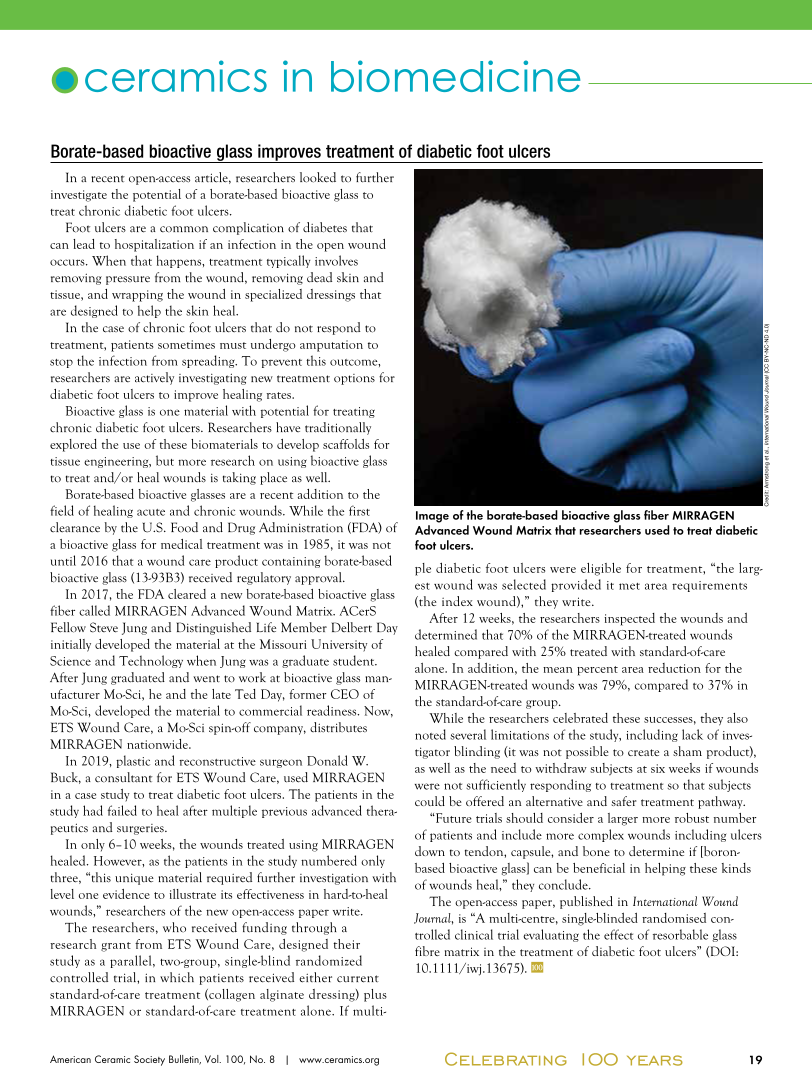American Ceramic Society Bulletin, Vol. 100, No. 8 | www.ceramics.org 19 Celebrating 100 years In a recent open-access article, researchers looked to further investigate the potential of a borate-based bioactive glass to treat chronic diabetic foot ulcers. Foot ulcers are a common complication of diabetes that can lead to hospitalization if an infection in the open wound occurs. When that happens, treatment typically involves removing pressure from the wound, removing dead skin and tissue, and wrapping the wound in specialized dressings that are designed to help the skin heal. In the case of chronic foot ulcers that do not respond to treatment, patients sometimes must undergo amputation to stop the infection from spreading. To prevent this outcome, researchers are actively investigating new treatment options for diabetic foot ulcers to improve healing rates. Bioactive glass is one material with potential for treating chronic diabetic foot ulcers. Researchers have traditionally explored the use of these biomaterials to develop scaffolds for tissue engineering, but more research on using bioactive glass to treat and/or heal wounds is taking place as well. Borate-based bioactive glasses are a recent addition to the field of healing acute and chronic wounds. While the first clearance by the U.S. Food and Drug Administration (FDA) of a bioactive glass for medical treatment was in 1985, it was not until 2016 that a wound care product containing borate-based bioactive glass (13-93B3) received regulatory approval. In 2017, the FDA cleared a new borate-based bioactive glass fiber called MIRRAGEN Advanced Wound Matrix. ACerS Fellow Steve Jung and Distinguished Life Member Delbert Day initially developed the material at the Missouri University of Science and Technology when Jung was a graduate student. After Jung graduated and went to work at bioactive glass man- ufacturer Mo-Sci, he and the late Ted Day, former CEO of Mo-Sci, developed the material to commercial readiness. Now, ETS Wound Care, a Mo-Sci spin-off company, distributes MIRRAGEN nationwide. In 2019, plastic and reconstructive surgeon Donald W. Buck, a consultant for ETS Wound Care, used MIRRAGEN in a case study to treat diabetic foot ulcers. The patients in the study had failed to heal after multiple previous advanced thera- peutics and surgeries. In only 6–10 weeks, the wounds treated using MIRRAGEN healed. However, as the patients in the study numbered only three, “this unique material required further investigation with level one evidence to illustrate its effectiveness in hard-to-heal wounds,” researchers of the new open-access paper write. The researchers, who received funding through a research grant from ETS Wound Care, designed their study as a parallel, two-group, single-blind randomized controlled trial, in which patients received either current standard-of-care treatment (collagen alginate dressing) plus MIRRAGEN or standard-of-care treatment alone. If multi- ple diabetic foot ulcers were eligible for treatment, “the larg- est wound was selected provided it met area requirements (the index wound),” they write. After 12 weeks, the researchers inspected the wounds and determined that 70% of the MIRRAGEN-treated wounds healed compared with 25% treated with standard-of-care alone. In addition, the mean percent area reduction for the MIRRAGEN-treated wounds was 79%, compared to 37% in the standard-of-care group. While the researchers celebrated these successes, they also noted several limitations of the study, including lack of inves- tigator blinding (it was not possible to create a sham product), as well as the need to withdraw subjects at six weeks if wounds were not sufficiently responding to treatment so that subjects could be offered an alternative and safer treatment pathway. “Future trials should consider a larger more robust number of patients and include more complex wounds including ulcers down to tendon, capsule, and bone to determine if [boron- based bioactive glass] can be beneficial in helping these kinds of wounds heal,” they conclude. The open-access paper, published in International Wound Journal, is “A multi-centre, single-blinded randomised con- trolled clinical trial evaluating the effect of resorbable glass fibre matrix in the treatment of diabetic foot ulcers” (DOI: 10.1111/iwj.13675). 100 Image of the borate-based bioactive glass fiber MIRRAGEN Advanced Wound Matrix that researchers used to treat diabetic foot ulcers. ceramics in biomedicine Borate-based bioactive glass improves treatment of diabetic foot ulcers Credit: Armstrong et al., International Wound Journal (CC BY-NC-ND 4.0)
(c) 2024 American Ceramic Society. All Rights reserved.




















































